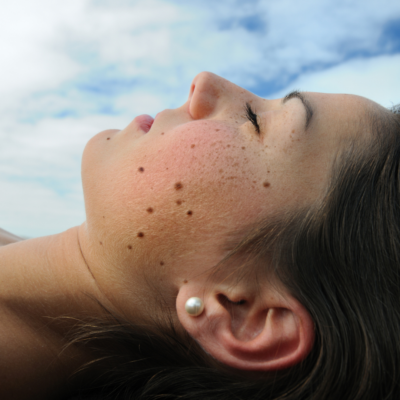
9 Ways to Update Your Skincare Regimen
After spending countless days indoors, whether due to weather or coronavirus precautions, you could probably use a refresh. A good place to start is with your skincare.
As you’re no doubt aware, beautiful, healthy skin starts with how you care for yourself on the inside. Take a look at your lifestyle. Are you getting enough exercise, hydration and sleep? Diet is also crucial. Include plenty of foods rich in skin-nourishing nutrients like omega-3 fatty acids, zinc, and vitamins A, C and E. And please steer clear of cigarettes and too much coffee or alcohol.
Now, consider how you take care of your skin on the outside. When was the last time you reassessed? It’s easy to fall into a rut. Take this opportunity to ditch suboptimal habits and to declutter your skincare, focusing only on what works for your unique skin.
Here are nine recommendations for updates to improve your regimen:
1 – Get rid of expired products.
Expired skincare products don’t deliver the same results as fresh products. On top of losing potency, they are more likely to host germs, bacteria, viruses and mold. Using them could leave you with adverse skin reactions such as rashes, irritation, bacterial infections, breakouts or hives.
Protect your skin by regularly checking your products for freshness. On each container, look for an expiration date, which is displayed on some products. Also search for the tiny open-jar symbol. It shows the safe use period after opening (PAO) in number of months (e.g., “6”, “12”, “24”, “36”). Then think back to when you first opened the product. Dispose of it if you’ve gone beyond either the expiration date or PAO period.
You may have trouble finding these limits or remembering when you first opened that face cream. Just bear in mind that many skincare products start dipping below acceptable efficacy and freshness after being open for about one year. For eye products, the PAO is usually closer to three months. Some products can become contaminated and irritating sooner. Keep on the lookout for an “off” smell, consistency or color. When in doubt, throw it out!
2 – Try something new.
Go through your skincare products, from cleanser to eye cream. One by one, ask yourself: “Does this bring my skin joy?” If any are only meh or a matter of habit, it’s time for some change. First, declutter. Purge all those shrug-worthy products, leaving your one favorite product per type. Second, assess. Decide which are still no better than “just fine.” Third, replace these. Lucky you: it’s an exciting time to shop for new skincare products!
No matter what your skin type, you can now select from a huge and growing number of cutting-edge formulations and ingredients. If your main concerns are sun damage and wrinkles, for instance, human growth factors have shown impressive results and L-ascorbic acid paired with tetrahexyldecyl ascorbate make an anti-aging, vitamin-C power couple. For dry skin, there are new formulations able to prevent transepidermal moisture loss. They mimic your natural skin barrier with a proven balance of ceramides, fats and phytosphingosine. Oily or combo skin? It’s extra important that you opt for gentle, oil-free, non-comedogenic products. Look for chemically exfoliating ingredients like glycolic acid, salicylic acid or retinol (vitamin A) to help keep your skin looking clearer and more youthful. In fact, glycolic and retinol are great for addressing dullness and signs of age in any skin type.
Whatever you choose, give new skincare products at least six weeks to start showing results.
3 – Stop touching your face.
During the pandemic, we’ve all become a little more aware of face touching. It can expose you to colds, COVID-19 and other communicable diseases. Similarly, you shouldn’t touch your face for skin health. Just as your hands pick up pathogens, they also pick up germs, dirt, bacteria, allergens, and irritating, congesting or oxidating residues.
Some experts advise avoiding touching your face even if it’s to apply makeup. Use makeup brushes and sponges instead, washing them frequently to keep them clean and cootie free. You won’t completely eliminate face touching, but you will at least reduce it.
4 – Wash your face every night.
Heard of makeup addiction? It’s when you wear makeup so continuously that your skin looks progressively worse without it. The worse it looks, the more makeup you wear, and the harder it becomes to go without cosmetics. It’s important to give your skin generous breaks, leaving it washed and makeup free at minimum while you sleep.
Even if you don’t wear makeup, a nightly cleanse is a must. Pollutants, excess oil, dead skin cells, sunscreen — these are a few of the daily offenders that, when left on, can visibly compromise your skin. Regularly skipping the nightly wash can take its toll on the skin’s protective barrier, ability to regenerate, pore size, texture, clarity and more.
Keep your skin looking its healthy best. Cleanse with just a dab of a gentle cleanser. In order to avoid irritation, use lukewarm water and don’t scrub.
5 – Remove your eye makeup too.
Some nights it may be tempting to splash your face and call it clean, ignoring that mascara and smoky eyeshadow. (We’ve all been there.) Resist!
Sleeping regularly in eye makeup can cause damage that extends beyond racoon eyes in the morning. It can contribute to eyelash thinning, crows feet, puffiness, and discolored and dehydrated skin around your eyes. Makeup is also more likely to make its way into your eyes while you sleep, potentially leading to irritation, styes or a nasty infection. Instead, remove eye makeup using a gentle product that doesn’t require any rubbing. Do it every night to keep your eyes looking youthful and bright.
If you’ve already experienced some lash loss, it’s not too late. Ask your dermatologist about Latisse to grow them back.
6 – Moisturize all of your skin.
So much focus is on the face in both the social and the professional sphere, especially with the rise of video meetings. It’s easy to overlook the skin on your body until there’s an issue. But why wait until you have ashy elbows, flaky shins or a dehydrated neck?
Skin dries out when it doesn’t retain sufficient moisture. Common causes of transepidermal water loss are aging, heredity, dry air, heat, insufficient water consumption, sun damage, and harsh soaps and cleansers. A good body lotion bolsters the skin’s ability to lock in water. Apply moisturizer regularly from the neck down to make your skin soft, supple and smooth all over. Pay special attention to your hands, elbows and feet.
7 – Never leave the house without SPF.
Make this vow to your skin: “I promise that I will never step out into daylight before first applying sunscreen with SPF 30+.” If you have very dark skin, you might think this one isn’t for you. On the contrary, even the deepest skin tone gives protection equal to only about 13 SPF. That means everyone’s skin is susceptible to sun damage — wrinkles, moisture loss, burns, cancer, roughness and discoloration — and even on an overcast day.
Be sure to apply a sunscreen for lips, particularly for those times you’re outdoors and mask-free. The protection and conditioning will help keep them soft and moist, so every day can be as kissable as Valentine’s Day.
8 – Book a facial treatment.
A consistent at-home self care routine is your best bet to keep skin beautiful. In addition to nutrition and fitness, your regular skincare habits are crucial. It can be difficult, however, to sift through all the beauty advice out there and identify what is credible and will work best for your skin. Taking some treatments into your own hands — like pore clearing, a strong glycolic peel or pimple popping (naughty!) — could leave you with irritated, angry skin and even scarring.
Skincare planning and treatments are best left to the beautiful-skin professionals. Work with an expert to customize a skincare program just for you. They can provide guidance for your daily regimen, periodic skin maintenance and advanced treatments.
Trust your skin to a pro for services including a relaxing, circulation-stimulating facial; a smoothing and rejuvenating peel; skin brightening microdermabrasion; or blemish-free acne extractions. Some dermatologists recommend regular aesthetician visits starting when patients are as young as 22 years old. Oh, and anyone who has ever gotten a good facial will recommend it, not only for vibrant and dewy skin, but also because it feels relaxing and wonderful. Treat yourself!
9 – See a dermatologist regularly.
Most people know that they should see a board-certified dermatologist at least once a year to check moles, address any medical issues and assess overall skin health. What you may not realize is that the right dermatologist will also offer advanced services to help your skin look amazing.
Many dermatologists can provide beauty procedures such as:
- Dermal fillers — Add skin volume, plump lips, fill wrinkles, and give your face subtle lift and definition with Restylane, Bellafill, Juvederm, Sculptra or Radiesse.
- Botox (also Xeomin and Dysport) — Relax underlying facial muscles to banish existing wrinkles and prevent new ones.
- Laser resurfacing — Remove sun damage, tighten skin, smooth out wrinkles, soften rough areas, and more.
- Laser color correction — Get rid of facial redness, zap away broken capillaries, erase tattoos or lighten hyperpigmentation.
- Plastic surgery — Smooth and tighten your skin by removing extra pockets of fat from trouble areas such as the neck, face, upper arms, thighs, abdomen, forehead and around the eyes.
The next time you can give yourself a little “me” time, revisit your skincare products and practices. Are there any positive updates you can make? For professional guidance, planning and services, partner with a board-certified dermatologist or advanced practitioner.
Individual results may vary and are not guaranteed.



 / 291 Reviews
/ 291 Reviews